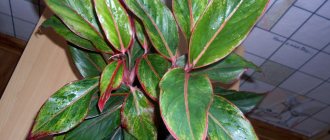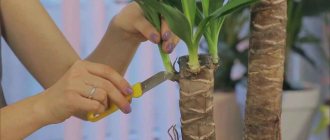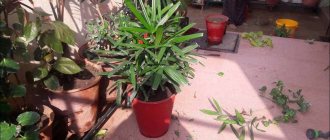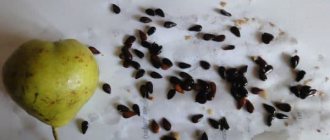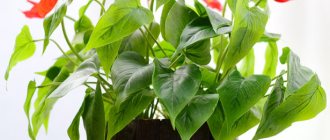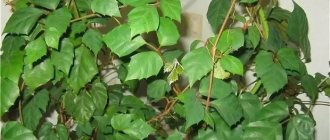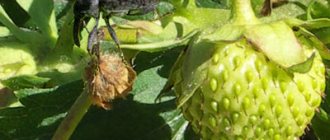Category: Care
Published 11/07/2018 · Comments: 0 · Reading time: 12 min · Views:
5 698
Hovea
The palm tree is perhaps one of the most striking attributes of paradise. Together with the azure ocean gently rolling onto the golden sandy shore, a comfortable hammock and an exotic cocktail, it represents the picture of an ideal vacation.
However, firstly, not all palm trees look standard - a trunk with a fan of leaves on the top. secondly, this plant can grow not only in nature, but also at home. Therefore, if you can’t get closer to wild tropical beauties, you can have your own palm tree - a small piece of the tropics in your home, pleasing to the eye all year round.
Today, these indoor flowers are quite common and acquiring such exotic flowers is not difficult. The only thing that can stop you is the price; even for a far from rare date palm you will have to pay a tidy sum. But palm seeds will help solve the problem - their cost will not put a dent in the family budget, and the growing process itself can be seriously captivating and delight you with an excellent result. The main thing is to know how to do everything correctly so that a palm grows from a seed.
Exotic plant for home
Of course, palm trees are still inferior in popularity to more traditional domestic plants - violets and geraniums. This is partly due to common biased judgments:
- these trees are too large for residential maintenance;
- they grow too slowly - taking a shoot, only our grandchildren will be able to admire the adult plant;
- to grow a palm tree as a houseplant requires a lot of knowledge, effort and time - this task is beyond the capabilities of an inexperienced gardener;
- The living conditions are absolutely unsuitable for these tropical guests.
However, most of the above are typical misconceptions. From the variety of palm trees suitable for growing indoors, you can choose the most suitable “pet”, and it will feel no worse than in its native tropics. When choosing, you should focus on 3 main factors:
- difficulty of germination and care;
- appearance - nevertheless, the plant must fit harmoniously into the interior;
- size of an adult palm tree.
Ideal for a small room: Chamedorea elegans (aka graceful); chrysalidocarpus and date palm. The last option is considered the most economical: you can get the seed material yourself by buying dates in the store and leaving their pits.
If the florist is the happy owner of high ceilings and a height of 2.5 m is not the limit, you should take a closer look at the taller and more impressive palm trees:
- Livistone Chinese (patching);
- Hamerops;
- Washingtonia filamentosa.
Livistona Chinese
Fans say that it is easier to buy an already mature plant, however, it is much more interesting to grow a palm tree yourself - from scratch, or more precisely, from a tiny seed. For many peoples, a palm branch is a significant symbol:
- since ancient times, the Chinese believed that it symbolizes dignity and fertility;
- on the Arabian Peninsula, the palm tree is considered the tree of life;
- for Christians, a palm branch is a symbol of eternal life, divine blessing and the biblical Garden of Eden;
- for early Catholicism it was a funeral symbol.
Today, the tree branch is found on the coats of arms of many states: Bolivia, Cuba, Cyprus, Sierra Leone and others. Here she talks about the country's territorial location and economic priorities.
How to get seeds - high-quality and fresh?
Good seed material is what you need to grow a palm tree from seeds, but where to get it, and most importantly, how to distinguish a quality product from an illiquid one?
Where can I buy seeds?
The most common way to purchase material for sowing is to purchase from an online store. Here you can encounter incredible abundance, find seeds of rare species, and also get useful information.
However, Russian flower growers also have more inventive options. For example, take seeds where palm trees grow in their natural environment. And in order to get to “warm regions” at the right time, you should plan your trip in advance. Moreover, many palm trees grow not so far away; they can be found on the streets of Crimea or the Caucasus.
Well, the third option is to eat dates and leave the seeds - at home it’s easy to get a plant from them. And besides, you can involve children in this process - who will rejoice at the emerging sprout more than the florist himself!
Freshness of seeds
Naturally, when buying seeds, you should pay attention to their freshness. In most species, germination depends on this property. However, there are exceptions - palm seeds, which grow in arid regions, can remain dormant for a long time, waiting for the right moment.
This is interesting! The seeds of the Washingtonia palm, which prefers to grow in desert areas, remain viable for more than ten years. They germinate immediately as soon as they find favorable conditions, but sometimes you have to wait quite a long time for them.
How to grow a palm tree from seeds
Growing a palm tree from seeds is probably the most interesting and exciting activity that a gardener can be interested in. For example, I was very curious: whether it germinates or not. And since you need to wait for an answer for more than six months, the interest becomes stronger the further you go.
I will tell you using the example of Hamedorea seeds. But, in principle, other types of palm trees can be grown in this way. We especially like to grow date palms.
When purchasing seeds, you should immediately pay attention to the packaging and expiration dates. Because old palm seeds have very low germination rates. If they were packaged a year ago, don’t buy them; they won’t sprout.
- Pomegranate: growing at home
To sow palm seeds, you can take plastic disposable cups (100-200 ml) and make holes at the bottom for drainage. We pour soil into them, consisting of leaf soil (1 part), perlite (1 part) and vermiculite (1 part). The mixture should be 1-2 cm below the edge of the cup.
Pre-soak the palm seed in water for 5 days. We clean it from the remnants of the fleshy shell. And we file down the hard coating a little using an abrasive stone or a file. All this speeds up the germination process.
We water the soil in a cup and bury the seeds of Hamedorea (or another palm tree) into the soil, one in each cup, with the sawed part down. There is no need to cover it with soil.
Then we set up a greenhouse for the seeds - we put a plastic bag on the glass. This way moisture will not evaporate from the soil. Place the cups with seeds in a warm (at least 25-27°C) and well-lit (at least 10-12 hours) place.
Now we are waiting for the seeds to germinate. We water it constantly. We ventilate once a day. And we wait. For a long time. The seeds of some palm trees take six to nine months to germinate.
When the sprouts are 2-4 cm long, transplant each one into an individual permanent pot using palm soil. For the first year, the young palm tree needs to be well shaded from direct sunlight.
- Dracaena or Cordyline?
Preparatory stage of sowing
A palm seed purchased in a store is usually already freed from the pulp and fibers of the outer shell. But sometimes unpeeled seeds are found on sale; in fact, they end up in the hands of flower growers in this form even when directly collected from a palm tree.
In these cases, before sowing, they must be cleared of pulp; there are two good reasons for this:
- The procedure will protect the material from rotting during germination.
- The pulp of palm seeds contains substances that slow down the germination process of the embryo.
To remove all particles of pulp, it is recommended to place the seeds in a container with warm water for 2-3 hours, and then scrape off all the remains. Then, it is advisable to soak them for several hours in a fungicidal preparation, for example, Fitosporin. Since the seeds of many palm trees “sit” in the ground for a very long time before germination, such treatment will reduce the likelihood of them rotting.
The prepared material should be thoroughly washed and soaked in warm water for 1–2 days. The water needs to be changed regularly to fresh, warm water. The duration of the event depends on how fresh the seeds are and how thick their protective shell is.
You can also keep the seeds for 10–12 hours in a solution of a growth stimulator: Vympel, Epine, Zircon. And then carry out disinfection: dilute a few drops of chlorine bleach (Domestos, Belizna, etc.) in a liter of water and place the seeds in the liquid for 7–10 minutes.
After all procedures are completed, it is advisable to scarify seeds with thicker and stronger shells in order to speed up their germination. To do this, one side part of the seed is filed with a file or needle file.
Important point! During scarification, it is important not to overdo it! If the shell is damaged through and through, the kernel may later rot.
Growing palm trees from seeds
When purchasing seed material, you need to pay attention to the packaging period. Palm seeds must be fresh. The old ones most likely will not germinate.
To speed up the germination process, seeds are treated before sowing:
Soak for two to three days in water, which is changed 2-3 times a day. At this time, the seed pulp swells and must be gradually removed. Together with the pulp, substances (inhibitors) that inhibit the development process will be removed.
Sawing or breaking the hard outer shell of seeds. To do this, use an abrasive stone or sandpaper. The entire layer cannot be completely destroyed. For speedy germination, only one small area is needed.
Further soaking of seeds for two to four days to stimulate germination.
To be sure that you will get an accurate palm shoot, it is recommended to plant several seeds at once.
Features of sowing
To plant seeds of the Hamedorea palm tree, as well as for Date palm, you need special soil, which includes:
- leaf soil - 1 part;
- vermiculite – 1 part;
- perlite – 1 part.
Each seed is planted in a separate disposable cup, at the bottom of which there should be a hole and drainage. The seed is placed in damp soil with the sawed side down. There is no need to cover it with soil.
In order for our palm trees to germinate better and faster, they need to organize greenhouses. To do this, plastic bags are placed on the cups.
You will be interested to know: Dracaena - types, meaning for the home
Conditions for seed germination
When propagating palm trees by seeds, it is necessary to create certain conditions:
- Soil moisture should be checked every day. The substrate should not dry out, but it should not be flooded either. It is best to spray the soil mixture with water at room temperature. Greenhouses should be ventilated daily by removing the bag from the cups.
- The temperature for germination of Hamedorea and Date Palm should be above +25 degrees.
- Lighting is also very important. Requires diffused light or partial shade for 10-12 hours a day.
Seeds take a very long time to germinate. You will have to wait from three to nine months. Therefore, you should be patient and do not forget to care for the crops.
The hatched sprouts should grow to 2-4 cm in length, then they can be transplanted from temporary pots to permanent ones. In the first year of cultivation, it is recommended to keep young plants away from direct sunlight. Diffused light is enough for them.
Planting process
Even an inexperienced gardener can plant a palm tree, however, a number of important nuances should be taken into account. First of all, palm trees are somewhat different from most house flowers, which means they have their own special needs:
- Palm trees can be sown regardless of the season, however, the sprouts require a well-lit place; if there is a lack of light, they will have to be provided with artificial lighting;
- germination and duration of germination are related to the shelf life of the seed material, so it is better to sow it immediately after purchase;
- prepared seeds are placed in a light soil mixture - this can be a ready-made material for germinating seeds; in addition, gardeners often use a mixture of perlite and vermiculite, with the addition of sphagnum or a substrate made of coconut fibers; they should be moistened, but not wet; It is advisable to first disinfect the material by steaming it for 8–12 minutes in the microwave;
- There is no need to place the seeds too deep; a depth of 1–2 times the diameter of the seeds is sufficient; if you deepen them too much, they begin to rot; if the seeds are scarified, they should be planted with the cut side down;
It is important! Vermiculite and coconut substrate can absorb moisture in large quantities, which can harm the seeds. Therefore, for beginners who have no experience in growing palm trees, it is better to start by using special ready-made compounds.
- You can take any container, but it is best to use containers made of transparent plastic with a lid - these are used to sell confectionery and baked goods; in a closed container, the seeds will not dry out, and thanks to the transparent bottom it is easier to observe the process of seedling growth;
- the planting should be placed in a warm place, the air temperature should be +25-+32 degrees; however, this indicator depends on the type of palm tree: for some, the normal germination temperature is +25 degrees, while for others, +30 is not enough;
- to eliminate the possibility of mold formation and rotting of seeds, daily ventilation should be arranged - it is enough to open the container lid for 15–20 minutes a day, ensuring free access of air;
- palm seeds grown at home do not need to be watered; as the substrate dries, the substrate should be carefully sprayed with a spray bottle;
Important nuance! During the heating season, containers with planting can be placed on the radiator only by placing a wooden board between them. But, in this case, it is necessary to regularly measure the temperature of the substrate. If the thermometer shows that it is very high, the seeds can literally “cook”!
Some particularly advanced “palmaholics” purchase special mini-greenhouses, with installed heating devices and a thermostat. But this pleasure is not cheap.
In summer, a container with palm seeds can be placed on the windowsill, but you just have to consider the following:
- the window sill should be warm, without drafts and constant shadow;
- The substrate and seedlings should not be exposed to direct sunlight.
If there is no place with suitable conditions, then there is a way out: future palm trees will feel good on the cabinet, where the thermometer will always show more degrees than in other areas of the room.
Note! To get better results, you can plant several seeds in pots with home flowers. They will sit in the ground longer, but in such conditions their germination rate increases.
How to care for a plant
Appropriate place
For a pot with a palm tree, you need to prepare approximately a square meter of space in the room. Large species require even more space. Small flowers will fit on the windowsill, but for a pot with large plants you will have to make room on the floor. It is better to place other plants away from the palm tree.
Correct capacity
Palm seeds will be comfortable in a 200 ml container; the next pot should be 500 ml. The new container should be one third larger than the previous one. It is better to take a plastic or ceramic pot with a tray.
The older the palm tree, the larger the pot it needs.
The soil
Two types of soil are suitable: a special mixture available in stores, or a mixture of humus, turf, sand, drainage should be placed at the bottom. The mixture may contain mineral fertilizers. When the plant grows, the humus in the mixture must be replaced with peat. The soil should be loose.
Lighting
There should be enough light for the palm tree. In winter, it is recommended to change the position of the pot so that the sun's rays reach the flower. During the period of active sun, the flower should not be exposed to direct rays of the sun, but to diffused light. You need to move the pot away or make thick curtains on the windows.
Humidity
It is necessary to maintain optimal humidity in the container: the lower part of the earthen mixture should always be wet, dampness should not be allowed. The leaves should be sprayed regularly to prevent yellowing and due to dry air, or placed near a container of water.
How to water
Watering depends on the type of palm tree; the water must be settled and its temperature not lower than the room temperature. In winter, you can water less often - once every two to three weeks, in warm weather - as the soil dries.
There should be holes in the drainage through which excess water will seep out to prevent flooding of the soil.
Transfer
Any plant, including a palm tree from seeds, must be replanted after the appearance of several leaves. During the active growth phase, the flower is transplanted annually, then once every 2-3 years. When replanting, you need to take care of the roots; you should pull the palm tree out of the pot along with the soil, which turns into a dry lump without watering. A large flower can be transplanted by transshipment.
Transplanting seedlings
As a rule, it is recommended to replant seeds that have roots - each sprout into a separate container. It is convenient to use plastic cups for these purposes, and large seeds can be immediately placed in small pots.
However, some are in no hurry to plant them and initially place the sprouted seeds in a damp cloth and place them in a warm place where there is a lot of light. It is better to pre-treat them with a fungicidal agent. As soon as the seeds have 1.5-2 cm seedlings, they can be moved to a separate tank.
It is also better to send the soil mixture for sterilization or treat it with fungicides.
If a “palm” hatches in a container with another flower, then removing it is not so easy. To do this, you need to remove the plant together with a lump of earth, carefully remove the sprout and transplant it into a separate tank.
This is interesting! Practice shows that palm trees sprouted in “foreign” pots turn out to be stronger and develop faster than their counterparts from the substrate.
Most palm trees experience severe stress during transplantation, so when working with the plant, you should carefully handle the root system to avoid damage.
How to care for sprouts?
Palm seedlings can be puzzling to novice gardeners. In some species they are similar to each other and look like blades of grass - green with pointed tips. But in sago palms, the sprouts have a spherical shape; tightly rolled and pubescent balls grow, gradually unfolding and turning into a feathery leaf.
But more often, young palm trees are tufts of grass blades that do not remotely resemble an adult plant. And for the shoots to turn into an exotic beauty, it is important to properly care for them: provide suitable conditions and know what fertilizers and fertilizing they require. In fact, sprouts need everything that mature palm trees need.
The soil
The easiest way is to use special soils for palm trees, which can be purchased at any store. They have all the necessary properties: lightness, friability, moisture permeability. But you can also prepare your own soil mixture, which includes humus, turf and coarse sand in equal proportions. For a grown plant, it is better to change the composition of the soil - humus is replaced with peat.
Drainage must be placed at the bottom of the pot: fine crushed stone, brick chips, vermiculite or expanded clay. The container must have holes through which excess moisture escapes.
Lighting
All palm trees are light-loving; in winter it is recommended to rotate the plant pot so that the sun reaches all parts. But on a hot afternoon it is better to protect the flower from direct sunlight; the light should be diffused.
Humidity
When growing a palm tree at home, special attention should be paid to this aspect: the lower part of the soil mixture should be moistened all the time, but dampness should not be allowed.
The leaves are periodically sprayed with a spray bottle to prevent them from yellowing due to dry air. You can also place a container of water near the pot with sprouts.
Features of watering
Regardless of the type of plant, water for irrigation should be at room temperature; it must first be settled for several days. In winter, the amount of watering is reduced - once every 14-21 days is enough. In summer and spring, the plant is watered as needed when the soil dries out.
Palm tree propagation by dividing the bush
Not many palm trees reproduce by branching or dividing the bush. Among the widespread ones is, for example, Hamedorea. Other types of palm trees are either impossible to propagate in this way or too troublesome.
But in the case of Hamedorea, propagating a palm tree in this way is preferable than from seeds. This way you will get results faster. If you have to wait about six months for a sprout to emerge from the seeds, then it will take 4-6 weeks for rooting by dividing the bush. And after 4 months you will receive a young plant.
Separation of a young bush from the main one should be done during the growing season - best in May. At this time, transplantation of mature palm trees is usually carried out. So, during transplantation, you need to separate the young branch, which is located on the side. It is better to take a shoot no higher than 25 cm so that it takes root more easily. Also, a young Hamedorea bush should have flexible stems, a fully formed small branch and its own roots.
We free the roots of the adult palm tree and the shoot from the ground (so that you can see where to cut). Carefully separate the young bush using a knife, while cutting the connecting roots as close as possible to the main part of the palm tree. Sprinkle the sections with charcoal, crushed into powder.
Pour soil for palm trees or a mixture of leaf humus (2 parts), turf soil (1 part) and perlite (2 parts) into a small pot. We place the shoot there, water it and sprinkle it with soil. We also plant an adult plant, but in fresh soil.
We place the young Hamedorea for rooting in a warm place (temperature about 30-35°C). If possible, you can make a frame over the pot from thin wire and stretch a transparent bag over it to create a greenhouse. This is especially recommended if the house is not very warm even in May. If you don’t have a greenhouse, then the required humidity can be provided by constant spraying.
Watering is also needed frequently, but as the top layer of soil dries out. This is important, since excessive watering can cause the roots to rot. This is how watering a branch differs from watering a seed - it needs more soil moisture.
- Liviston at home: care and types
If you did everything correctly, then the new Hamedorea palm tree will take root within a month. But she needs to grow in a temporary pot for another 3 months to gain strength. Then it can be transplanted into a permanent flowerpot.
And, as they say, as an alaverda. Although growing a palm tree from seeds is a longer process , it is quite feasible. In addition, almost all types of palm trees can be germinated in this way. So if you have the patience, I recommend choosing the method of growing palm trees from seeds.
How and when to replant a grown palm tree?
There is no need to rush into this activity, since most palm trees grow slowly and do not tolerate moving very well. This is usually done when the root system of the flower becomes crowded; the transshipment method is used - moving the flower into a larger pot along with a lump of earth.
It is important! You should not select a container for growth; it should be slightly larger than before. This will make it easier for the plant to explore the space and its root system will not rot.
If palm trees are not transplanted carefully and the roots are damaged, their growth will slow down and may even stop for a long period until recovery.
When does a sprout become a mature palm tree?
Having learned that you can grow a palm tree at home and how simple it is, a novice florist, fired up by an idea, can rush to bring the idea to life. However, you should not count on quick results - it can take a very long time from planting a seed to its transformation into a large, spectacular flower.
Only hatched palm fry develop the slowest, but their growth gradually accelerates. Actually, even in their natural environment, these plants do not grow rapidly.
Sometimes it takes a year to a year and a half for a palm tree to become covered with real leaves, and in some species this happens only by 3–4 years.
The first true leaves usually do not at all resemble the foliage of an adult palm tree, but with each leaf the young palm tree will more and more resemble its taller relatives.
2-3 years after the appearance of the first complex leaves, the flower will turn into a beautiful tropical guest - luxurious and spectacular. But, until this moment, the owner will have to be patient.


